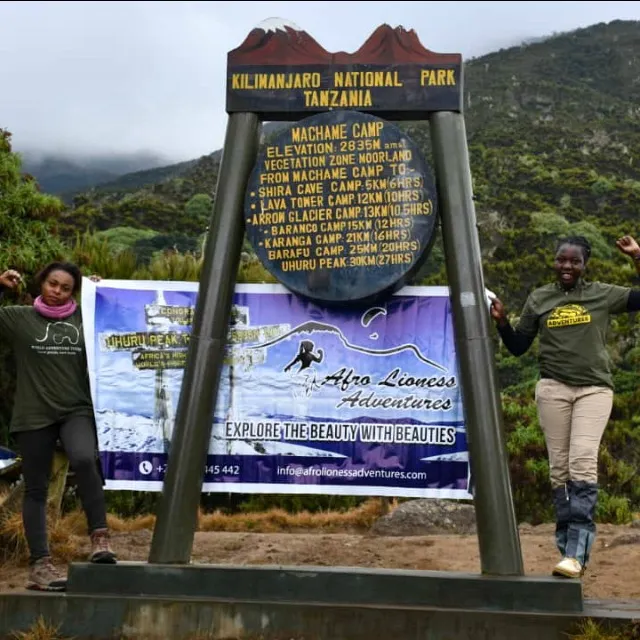Every year around 30,000 people from all over the world attempt to climb to the top of Mount Kilimanjaro – One of the Seven Summits of the World, Africa’s highest peak and the world’s tallest free-standing mountain at 5,895 metres. Around 60% of people make it, with most of those who do not abandoning their dream due to the…
HOW TO CONQUER MOUNT KILIMANJARO!
24/01/2021 Mount Kilimanjaro
Every year around 30,000 people from all over the world attempt to climb to the top of Mount Kilimanjaro – One of the Seven Summits of the World, Africa’s highest peak and the world’s tallest free-standing mountain at 5,895 metres. Around 60% of people make it, with most of those who do not abandoning their dream due to the effects of altitude sickness or low fitness levels and mental strength. The Professional Mountain Guides of Afro Lioness Adventures call upon their skills and years of experience in getting climbers safely up and down Kilimanjaro every month – assisting the majority to conquer this iconic, snow-capped volcano (fortunately now dormant!) and return home happily with a sense of pride and achievement. Last week our experienced mountain guides Agatha and Farida, supported a small party of tourists to reach the summit of Kili following the 6 day Machame Route (approximately 62 km/ 37 miles from gate to gate). One member of the group, unfortunately, did not make it to the summit due to suffering from altitude sickness; however, our guides returned them safely to the base of the mountain and went on to motive the rest of the party to successfully reach the top through a combination of practical advice and uplifting singing!
OUR TOP TIPS FOR CONQUERING MOUNT KILIMANJARO
- Get physically fit before you leave home: Cardio-strength, muscle strength in the legs and flexibility will make your climb more enjoyable and ultimately aid success. Do some long day hikes in the weeks before your climb, as you will need to be able to walk 5-7 hours a day, with the final climb to the summit taking 6-8 hours and the descent taking 5-8 hours all on the same day!
- Pack only essential & good equipment: Temperatures on Kili can range from the high 20’s in the daytime to -15c at night, so layers of clothing are best to wear. Mittens are also a must plus a pair of comfortable walking boots – don’t try and break in new boots on the mountain! Kilimanjaro National Park operates a strict limit of 15kg per porter so pack efficiently and remember single-use plastic bags are banned in Tanzania!
- Travel at the best time: May to October and December to March are the best months to climb when the weather is mostly dry and clear, although you will share the experience with more climbers! Many of our clients extend their time by adding a safari before or after their climb, as the Serengeti other parks are nearby, so keep this in mind if you also want to view specific animals during your trip.
- Choose a route to the top to match your level of skill: There are four routes up Kilimanjaro that we recommend within National Park: the Machame Route (most popular), Lemosho route, Rongai route and the Northern Circuit. Some are more challenging than others so read about them online and decide which you think will best suit your time and fitness level. We are happy to help you make the right decision.
- Climatisation – Pole! Pole! (i.e. slow and steady!) Ascending Kili too quickly can result in Altitude Sickness and mean the end of your climb. As you ascend, the oxygen content in the air drops rapidly, meaning that with every breath you are getting less power and moving more slowly. By the time you reach the summit air pressure is down to 49% of what it was at sea level, so climatising your body is essential to reach the top. Unless you are an experienced climber we recommend taking a minimum 6 day climb, the more days the better! We also recommend simple breathing techniques along the way and suggest you think about packing some altitude sickness tablets just in case!
- Stay Hydrated and eat plenty: Fuel your climb! It is very easy to dehydrate at altitude without noticing. The air is very dry so you breathe off more moisture. Also, your body adjusts to the high altitude by eliminating more water. Keep replacing it. Most people also lose their appetite at altitude, but the cold weather and the long days mean your body burns through a lot of calories. Keep replacing them!
- Nurture a positive mindset: The biggest difference between those who reach the summit successfully and those who turn back is often mental tenacity! Passion and self confidence will help you get to the top of anything you want to do in life!
- Use the services of an experienced tour guide company: You will not be able to climb Mount Kilimanjaro without the support of an experienced guide and a good company.on the ground. Our team at Afro Lioness Adventures grew up the mountain, and have thousands of hours of experience taking climbers of all levels up and down Kilimanjaro. They see being female as their greatest strength in assisting climbers to conquer Mount Kilimanjaro as ‘it is the woman who carries a child for 9 months and then has the daily responsibility to protect, nurture and inspire it to achieve great things in life’!

